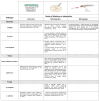Zebrafish (Danio rerio) as a Model System to Investigate the Role of the Innate Immune Response in Human Infectious Diseases
- PMID: 39596075
- PMCID: PMC11593600
- DOI: 10.3390/ijms252212008
Zebrafish (Danio rerio) as a Model System to Investigate the Role of the Innate Immune Response in Human Infectious Diseases
Abstract
The zebrafish (Danio rerio) has emerged as a valuable model for studying host-pathogen interactions due to its unique combination of characteristics. These include extensive sequence and functional conservation with the human genome, optical transparency in larvae that allows for high-resolution visualization of host cell-microbe interactions, a fully sequenced and annotated genome, advanced forward and reverse genetic tools, and suitability for chemical screening studies. Despite anatomical differences with humans, the zebrafish model has proven instrumental in investigating immune responses and human infectious diseases. Notably, zebrafish larvae rely exclusively on innate immune responses during the early stages of development, as the adaptive immune system becomes fully functional only after 4-6 weeks post-fertilization. This window provides a unique opportunity to isolate and examine infection and inflammation mechanisms driven by the innate immune response without the confounding effects of adaptive immunity. In this review, we highlight the strengths and limitations of using zebrafish as a powerful vertebrate model to study innate immune responses in infectious diseases. We will particularly focus on host-pathogen interactions in human infections caused by various bacteria (Clostridioides difficile, Staphylococcus aureus, and Pseudomonas aeruginosa), viruses (herpes simplex virus 1, SARS-CoV-2), and fungi (Aspergillus fumigatus and Candida albicans).
Keywords: animal model; bacteria; fungi; host-pathogen interaction; infectious disease; innate immune response; virus; zebrafish.
Conflict of interest statement
The authors declare no conflict of interest.
Figures



Similar articles
-
Infectious disease models in zebrafish.Methods Cell Biol. 2017;138:101-136. doi: 10.1016/bs.mcb.2016.10.005. Epub 2016 Dec 2. Methods Cell Biol. 2017. PMID: 28129840 Review.
-
Larval zebrafish burn wound infection model reveals conserved innate immune responses against diverse pathogenic fungi.mBio. 2025 May 14;16(5):e0348024. doi: 10.1128/mbio.03480-24. Epub 2025 Apr 8. mBio. 2025. PMID: 40197062 Free PMC article.
-
Modeling Virus-Induced Inflammation in Zebrafish: A Balance Between Infection Control and Excessive Inflammation.Front Immunol. 2021 May 7;12:636623. doi: 10.3389/fimmu.2021.636623. eCollection 2021. Front Immunol. 2021. PMID: 34025644 Free PMC article. Review.
-
Zebrafish: model for the study of inflammation and the innate immune response to infectious diseases.Adv Exp Med Biol. 2012;946:253-75. doi: 10.1007/978-1-4614-0106-3_15. Adv Exp Med Biol. 2012. PMID: 21948373 Review.
-
Infection of zebrafish embryos with intracellular bacterial pathogens.J Vis Exp. 2012 Mar 15;(61):3781. doi: 10.3791/3781. J Vis Exp. 2012. PMID: 22453760 Free PMC article.
Cited by
-
Ochratoxin A induces immunotoxicity by targeting Annexin A1 mediated neutrophil apoptosis in zebrafish.Front Immunol. 2025 Jan 24;16:1542964. doi: 10.3389/fimmu.2025.1542964. eCollection 2025. Front Immunol. 2025. PMID: 39925799 Free PMC article.
-
Modeling Pseudomonas aeruginosa-Staphylococcus aureus interactions in zebrafish to assess the host inflammatory response upon co-infection.Sci Rep. 2025 Jul 4;15(1):23965. doi: 10.1038/s41598-025-08459-4. Sci Rep. 2025. PMID: 40615487 Free PMC article.
-
Zebrafish do not have a calprotectin ortholog.PLoS One. 2025 May 2;20(5):e0322649. doi: 10.1371/journal.pone.0322649. eCollection 2025. PLoS One. 2025. PMID: 40315184 Free PMC article.
-
Zebrafish as a tool for autism research: unraveling the roles of Shank3, Cntnap2, Neuroligin3, and Arid1b in synaptic and behavioral abnormalities.Neurogenetics. 2025 Jun 6;26(1):48. doi: 10.1007/s10048-025-00828-5. Neurogenetics. 2025. PMID: 40478461 Review.
-
Genome-wide identification of the interferon complex establishes IFNf in Cypriniformes.BMC Biol. 2025 Jul 7;23(1):202. doi: 10.1186/s12915-025-02319-3. BMC Biol. 2025. PMID: 40619370 Free PMC article.
References
-
- Baldridge D., Wangler M.F., Bowman A.N., Yamamoto S., Undiagnosed Diseases Network. Schedl T., Pak S.C., Postlethwait J.H., Shin J., Solnica-Krezel L., et al. Model organisms contribute to diagnosis and discovery in the undiagnosed diseases network: Current state and a future vision. Orphanet J. Rare Dis. 2021;16:206. doi: 10.1186/s13023-021-01839-9. - DOI - PMC - PubMed
-
- Liu Z.-J., Qian X.-K., Hong M.-H., Zhang J.-L., Li D.-Y., Wang T.-H., Yang Z.-M., Zhang L.-Y., Wang Z.-M., Nie H.-J., et al. Global view on virus infection in non-human primates and implications for public health and wildlife conservation. Zool. Res. 2021;42:626–632. doi: 10.24272/j.issn.2095-8137.2021.080. - DOI - PMC - PubMed
Publication types
MeSH terms
Grants and funding
LinkOut - more resources
Full Text Sources
Miscellaneous

